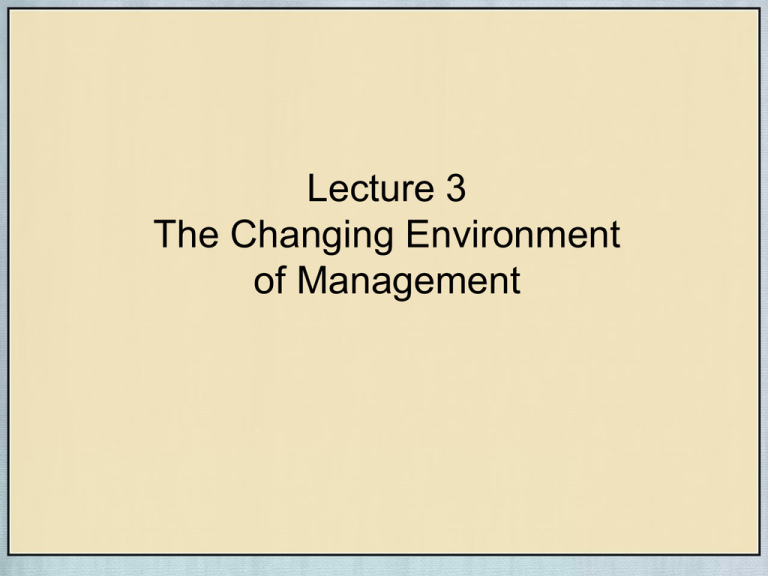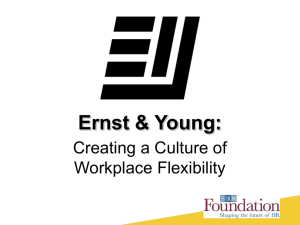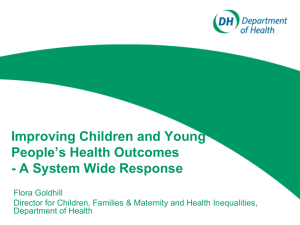managing diversity
advertisement

Lecture 3 The Changing Environment of Management Lecture Objectives • Summarize the demographics of the new global workforce. • Explain how the social contract between employer and employee has change over the years. • Define the term managing diversity, and explain why it is particularly important today. Lecture Objectives • Discuss how the changing political-legal environment is affecting the practice of management. • Discuss why business cycles and the global economy are vital economic considerations for modern managers. • Describe the three-step innovation process, and define the term intrapreneur. The Twenty-First-Century Workplace: Seven Major Changes 1. 2. 3. 4. The Virtual Organization The Just-in-Time Workforce The Ascendancy of Knowledge Workers Computerized Coaching and Electronic Monitoring 5. The Growth of Worker Diversity 6. The Aging Workforce 7. The Birth of the Dynamic Workforce The Social Environment • Dimensions of the Social Environment – Demographics • Changes in the statistical profiles of population characteristics – The new social contract • Changes in the employer-employee relationship – Inequalities • Persistent barriers encountered by women, minorities, and others in the workplace – Managing diversity • Creating organizational cultures that enable all employees to realize their potential Demographics of the New Workforce • Myths About Older Workers – They are less productive. – They incur higher benefits costs. – They have higher absenteeism. – They have more accidents at work. – They are less willing to learn. – They are inflexible about the hours they are willing to work. Figure 3.1: The Changing U.S. Workforce, 2002-2012 Figure 3.1: The Changing U.S. Workforce, 2002-2012 (cont’d) Figure 3.1: The Changing U.S. Workforce, 2002-2012 (cont’d) Figure 3.1: The Changing U.S. Workforce, 2002-2012 (cont’d) A New Social Contract Between Employer and Employee • New Social Contract – The assumption that the employer-employee relationship will be a shorter-term one based on convenience and mutual benefit, rather than for life • Employees are expected to manage their own careers to increase their long-term value. • Employers are expected to provide the means necessary for continual workforce development. Nagging Inequalities in the Workplace • Under the Glass Ceiling – Women continue to experience a significant gender-wage gap and strong barriers to advancement. – Women are demanding more equitable compensation and workplace opportunities. • Continuing Pressure for Equal Opportunity – Women, minorities, and the physically challenged are all expected to press harder for more employment opportunities. Nagging Inequalities in the Workplace (cont’d) • Part-Timer Promises and Problems – Contingent workers will comprise an increasing percentage of the workforce. – The advantages of lower wage and benefits costs and the flexibility of a contingent workforce are offset by their negative work attitudes and increased likelihood of quitting. Managing Diversity • Managing Diversity – The process of creating an organizational culture that provides all employees, including women and minorities, with assistance and opportunities to help them realize their full potential The Political-Legal Environment • The Politicization of Management – Issues management • Ongoing process of identifying, evaluating, and responding to important social and political issues • Purpose: Minimize “surprises” and make more systematic and effective responses to issues – General political responses • Defending the status quo against all comers • Adopting a “wait and see” approach • Proactively trying to identify and respond to issues Figure 3.2: Management’s Political Response Continuum The Economic Environment • The Job Outlook in Today’s Service Economy, Where Education Counts – The job category for “general managers and operations managers” is rapidly growing and one of the most resistant to “offshoring.” – Service sector jobs in high-paying occupations that require at least a bachelor’s degree are growing twice as fast as that of all other occupations. The Economic Environment • Coping with Business Cycles – Business cycles • Alternating periods of economic expansion and recession • The up-and-down movement of an economy’s ability to generate wealth • Worldwide convergence The Economic Environment • Cycle-Sensitive Decisions – Timing decisions about appropriate responses to changes in the business cycle is necessary to • Reduce the chances that a firm’s assets and resources will be underutilized or wasted in economic downturns • Take advantage of opportunities that will arise during periods of rapid economic expansion Figure 3.3: Business Cycles Affect Managerial Decisions The Challenge of a Global Economy • A Single Global Marketplace – Global trade is causing a shift to a single economy. – The commercial world is no longer East-West, NorthSouth; it is now one economy, one marketplace. • Globalization Is Personal – A growing trend: Working for a foreign-owned company – Meeting world standards for quality and costs (through lower wages) is necessary to be globally competitive. The Technological Environment • Technology – Technology includes all the tools and ideas available for extending the natural and mental reach of humankind. – Technology is facilitating the evolution of the information age. – Information has become a valuable strategic resource for gaining competitive advantage. The Technological Environment (cont’d) • The Innovation Process – The systematic and practical application of a new idea • Steps in the Innovation Process – Conceptualization: When a new idea occurs to someone – Product technology: Creation of a working prototype – Production technology: Development of a profitable production process Figure 3.4: The Three-Step Innovation Process The Technological Environment • Innovation Lag – The time it takes for a new product to be translated into satisfied demand • Shortening Innovation Lag – Goal setting: Creating a sense of urgency and purpose – Empowerment: Pushing decision-making authority down to the level of the decision – Concurrent engineering: Using a team approach to product design involving specialists from all functional areas including research, production, and marketing Promoting Innovation Through Intrapreneurship • Intrapreneur – An employee who takes personal responsibility for pushing an innovative idea through a large organization • Fostering Intrapreneurship – – – – Focus on results and teamwork. Reward innovation and risk taking. Tolerate and learn from mistakes. Remain flexible and change-oriented. Summary • The global workforce will continue to become larger, older, more diverse, and more female. • The traditional social contract has been replaced by a shorter-term relationship of convenience between employee and employer. • Persistent opportunity and income equalities are powerful stimuli for workplace changes that will tap every employee’s full potential. Summary (cont’d) • Managers are becoming increasingly politicized and more likely to be held personally responsible for their decisions and actions. • Business cycles and the emerging global economy affect the decisions managers make. • Intrapreneurship can flourish in an organizational climate that values individuals who champion ideas and innovations.







